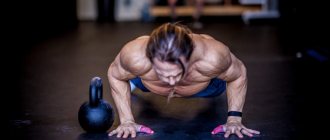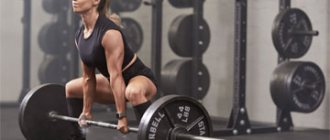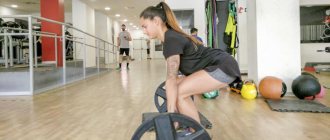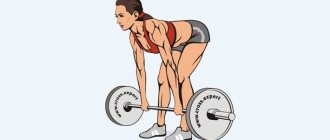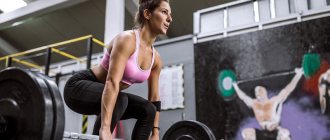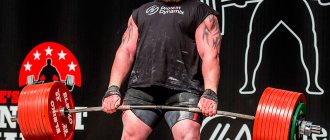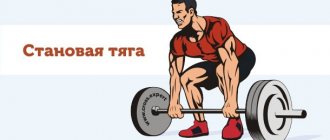Share:
What you need
- Barbell
The Romanian barbell deadlift is one of the most effective exercises for developing the muscles of the back, hamstrings and buttocks. As usual, where there is efficiency, there are injuries. You need to approach training with this exercise extremely carefully. After all, the key to a safe workout is the correct technique for performing the exercise. Today we will tell you about it, as well as about the main mistakes and features of this Romanian deadlift.
Features and varieties
Often, beginners confuse the classic and Romanian deadlift with a barbell. (here are details about all types of barbell deadlifts). At first glance, they are really similar, but they have a number of differences. The classic type of deadlift is done in the direction of movement from bottom to top with legs bent at the knees. The pelvis drops quite low relative to the floor. On the next repetition, the bar actually touches the floor. Unlike the classics, the Romanian deadlift is carried out by moving from top to bottom exclusively on straight legs, and the barbell is lowered only to the middle of the shin.
Active and static effects are exerted on different muscle groups depending on the chosen type of Romanian deadlift:
- With dumbbells. It is performed using the same technique as the Romanian barbell deadlift. At the same time, it is considered a more traumatic and less effective exercise due to the uneven distribution of weight on the spine.
- Romanian single leg deadlift. This type of exercise is performed in a position on one leg – the supporting one. The dumbbell is taken in the hand opposite to the supporting one. The body leans forward until it is parallel to the floor, stays in this position for a moment and returns to the starting position.
- Romanian deadlift on straight legs. The only distinguishing feature from the Romanian deadlift is perfectly straight legs without the slightest bend in the knee joints during the exercise.
- Romanian barbell deadlift. This is a multi-joint exercise. This exercise involves to varying degrees the biceps femoris, back extensors, lumbar muscles and gluteal muscles.
Recommendations
- This movement is more similar to a kettlebell swing than a deadlift. You need to move so that the buttocks are pulled back and brought to the neutral line;
- We choose the weight of the barbell so that it is a maximum of a third of the maximum maximum in a classic deadlift from the floor, if we are talking about an athlete;
- You should not overdo the weight, even if you are working on hypertrophy of the gluteal muscle;
- The exercise is not intended to stretch the hamstrings; this is a misconception. You should carefully perform it in that part of the amplitude in which it is comfortable for the leg muscles
What muscles are involved?
What muscles work during the Romanian deadlift? The exercise is rightfully recognized as one of the most effective for developing the muscles of the hip and back. The auxiliary muscles, the gluteal and calf muscles, are also included.
Basic load
The main load during the Romanian deadlift falls on:
- lumbar muscles;
- posterior thigh muscle group;
- trapezius muscles;
- quadriceps femoris, gluteus maximus.
Additional load
Also, let less stress be applied to the following muscles:
- anterior tibial;
- gluteus medius and minimus;
- deltoid;
- hip adductors.
An important feature of the Romanian deadlift is the large load on the lower back. Beginners are advised to first strengthen the lower back muscles with hyperextension. In addition, if you have back injuries, then it is wiser to abandon this exercise altogether.
During the training process, the largest muscle groups of the body are worked and significant weights are used. This helps produce enormous amounts of energy, and also stimulates the endocrine system and increases the release of growth hormone, testosterone and other anabolic hormones into the blood.
A little history
The story goes that in 1990, an Olympic weightlifter named Nicu Vlad from Romania, competing in San Francisco, demonstrated a lift similar to the modern Roman deadlift. Someone in the audience asked what it was called. He shrugged and said it was just to strengthen his back. There was an Olympic weightlifting coach from the United States there, and he called the exercise the Romanian deadlift, which is also called the Roman deadlift.
Exercise technique
Next, we will analyze in detail the technique of performing the Romanian deadlift. First of all, we recommend watching the entire process on video.
Basic Rules
Before you start learning the technique of performing the Romanian deadlift, you should learn some rules. Compliance with them will allow you to conduct training safely and effectively.
- The direction of movement of the exercise is from top to bottom. Therefore, it will be more convenient and safer not to lift the barbell from the floor, for example, as in the classic deadlift, but to install it on a special rack for the barbell at the level of the pelvis.
- The shoes are suitable with flat and wide soles. The presence of a heel is undesirable. The permissible heel height is 1 cm. Shoes must fit snugly on the foot. If your toes are allowed to rise in sneakers, your lower back may be injured due to the lack of stable support.
- The grip used is a classic straight one. The barbell is taken in the middle, at a distance slightly wider than the shoulders.
- When lowering the body down, the bar should pass closely along the legs. This ensures proper load on the lower back muscles. If the rule is not followed, the lower back will simply “rest” during the exercise.
Initial position
You should take the correct position to start the exercise:
- You need to approach the bar almost end-to-end so that the bar hangs over your ankle. Feet are placed shoulder-width apart, toes pointing straight forward. Take a medium grip - slightly wider than shoulder width.
- The back is flat and straight. The shoulder blades are slightly retracted. The body is tense. You need to remove the projectile from the stand or take it from the floor. In both cases, the back remains straight all the time.
- The pelvis moves slightly forward. This ensures precise vertical alignment of the entire body.
Thrust moment
Having assumed the correct starting position, the main muscle work begins:
- The body is lifted to the starting position without sudden movements or jerks.
- The barbell is lifted not by straightening the body, but by pushing the weight out with the legs.
- The foot is pressed tightly to the floor. Powerfully but smoothly, the floor seems to be pressed down and the body straightens.
Reverse movement
Having fixed in the lowest position for a few moments, the body returns to its original position:
- The body begins to fall down. It is important that at the same time the back remains straight, and the shoulder blades are also slightly brought together.
- The pelvis is retracted back to the maximum, but without a downward slope. There is tension in the gluteal muscles and stretching of the hamstrings.
- The knee joints are fixed throughout the exercise and remain in their original position.
- The bar slowly moves strictly vertically down and is brought to the middle of the shin. The back is not rounded.
Recipes for healthy eating
Potatoes with onions baked in the oven
- 1.9 g Protein
- 6.9 g Fat
- 15.6 g Carbohydrates
- 123 kcal
40-60 min.
- #vegetarian dish
- #second course
- #dietary
- #baking
- #green onions
- #potato
- #low calorie
- #dinner
- #olive oil
- #onion
- #cheese
- #dinner
- #garlic
Other recipes
Pro Tips: How to Do Romanian Deadlifts
When performed, the lumbar spine is under heavy load. With weak abdominal and lower back muscles, back injuries are possible, so trainers recommend performing the exercises only for trained athletes. The main preparatory exercises are hyperextension, extension and flexion of the hips on block machines, twisting the body, pulling blocks behind the head.
There are small nuances in the technique - when the body is tilted down, it is important to move the support to the heels, not just standing on the floor, but pulling the tailbone back. Thus, the body does not fall forward, but bends by moving the tailbone back.
Not only the lower back, but also the thoracic spine is under heavy load. It is important to stabilize the thoracic area with information about the shoulder blades. The shoulder blades are supposed to gather in the center of the back and the shoulders stretch to open the chest. The shoulder joints should not be raised upward, pinching the cervical spine.
The number of repetitions directly depends on the goals. In powerlifting, the main goal is to lift as much weight as possible in one lift. This method develops explosive power. To develop strength, the exercise should be repeated no more than 4-6 times. If the main goal is to gain muscle mass, then the exercise should be performed 8-12 times. To maintain muscle tone and reduce volume, endurance work is performed, that is, the number of repetitions exceeds 15 times in one approach. Beginners need to perform three approaches, more prepared ones need to perform 4 approaches of one exercise.
To prevent injuries and negative consequences, such as lumbar hernias, especially when working with heavy weights, it is recommended to use a special belt. Its width and density will stabilize the spine and prevent it from bending under heavy load. Such a belt can be bought in sports stores; it is in every gym. It's better to be safe and eliminate all risks of injury.
Common mistakes
Next, we will analyze the most typical mistakes when performing the Romanian deadlift with a barbell.
hunched back
A common mistake among beginners and amateurs. Making this gross mistake leads to a decrease in the effectiveness of the Romanian traction. In addition, rounding the back can cause injury to the spine.
Tip: When the bar is lifted off the floor or removed from the stand and at the highest point, the back should still be tense, and the spine should remain taut and perfectly straight.
Incorrect position of the boom
Often the athlete stands too far from the bar. Because of this, the back receives additional stress when removing the bar from the stand or lifting it from the floor.
Tip: The bar should be positioned directly above the athlete's ankle, that is, as close to the legs as possible.
Bend the arm at the elbow joint
With a large weight of the barbell, the athlete tries to “push” the bar by bending his arms at the elbow joints. This occurs because the hands and forearms are not strong enough to support the weight.
Advice: If such a problem arises, it is better to take less weight or use special straps. Such precautions will protect against injury.
Contraindications
Deadlifts for the buttocks, like any exercise with dumbbells or a barbell, are quite difficult to perform. Therefore, not everyone can master it.
There are a number of contraindications that must be taken into account:
- dysfunction of the musculoskeletal system;
- rachiocampsis;
- intervertebral hernia;
- protrusion;
- compression;
- disease of the wrist joints, elbows and shoulders;
- problems with the functioning of the heart and blood vessels.
Do not deadlift at elevated temperatures. In any case, before starting training, you should consult a doctor and an experienced trainer.
The best workout to strengthen your tendons
If you're neglecting the back of your legs, you can correct the problem by adding Roman deadlifts to your workout. This is a variation of the standard deadlift that engages your hamstrings, giving them flexibility and endurance. This exercise can be done anywhere because you don't need to use very heavy weights for it to be effective. Using a barbell at the gym is the easiest way to do the exercise, but you can do it at home with bottles of water, for example.
The Roman deadlift is equally good for both girls and men. The number of repetitions can be different, as well as the weight of the barbell. For example, you can do 3 sets of 10-12 repetitions. Rest 3 to 4 minutes between each set. This will give your muscles enough time to rest so that you can give your best effort to each subsequent round.
Good shoes for weightlifting
For best performance, you should also pay attention to clothing that is comfortable and shoes that provide a stable surface to help you balance and support heavy loads. This is especially important for exercises such as deadlifts, squats, and overhead presses. It should fit comfortably on your feet and leave no room for slipping. This provides good traction as there is no slipping or shifting during lifting. Proper weightlifting shoes not only improve the effectiveness of the exercise, but can also reduce the risk of injury.
